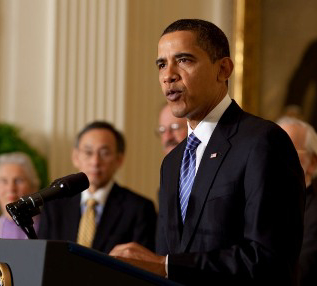Stem Cell Move Heralds Hopeful New Era for Biomedical Research and for AIDS

| Nobel Laureates stand behind President Barack Obama as he offers remarks Monday, March 9, 2009, in the East Room of the White House before the signing of the Stem Cell Executive Order and Presidential Memorandum on Scientific Integrity. White House Photo by Pete Souza. |
|
March 9, 2009—President Obama’s removal of the ban on federal funding of embryonic stem cell research signals a hopeful new era for medical research in general, and AIDS in particular. Of equal importance, it is a concrete example of the statement President Obama made in his inaugural address that he will “restore[s] science to its rightful place.”
Stem cell research could ultimately benefit people suffering from a host of disorders, including Alzheimer’s disease, Parkinson’s, diabetes, stroke, spinal cord injury, and rheumatoid arthritis. Its promise extends to HIV/AIDS, a global epidemic that has already killed more than 25 million people worldwide.
In terms of AIDS, last year a group of physicians from Berlin reported on an HIV-positive man who developed acute leukemia. In an attempt to cure his leukemia he underwent a stem cell transplant. This is usually standard treatment in such cases, but his transplant had a unique twist. Rather than simply using the best match among available stem cell donors, his physicians also screened donors for a natural genetic mutation, one that renders a person resistant to infection by the most common forms of HIV. Now off all anti-HIV drugs for over two years, this man has no detectable signs of HIV or leukemia.
This first documented case of a functional cure for AIDS offers a startling illustration of the potential of stem cell-based therapies. It is not practical to search for such special mutations among stem cell donors and these mutations do not exist among African-Americans or Asians. But the potential to use embryonic stem cells – the ones covered by the former ban – to engineer these mutant cells to be used in such treatments offers new hope for people with the disease.
“There are still many challenges to be overcome and much research to be done before stem cells could be considered as a treatment or a cure for HIV/AIDS,” said Kevin Robert Frost, chief executive officer of amfAR, The Foundation for AIDS Research. “But as a result of President Obama’s action today, that research might actually see the light of day.”
The President’s executive order comes at an opportune time for researchers, who will be able to apply for a portion of the $20 billion in supplemental funding for the National Institutes of Health that was included in the economic recovery package.
“Science offers our best hope for bringing the global HIV/AIDS epidemic to an end,” said Susan Blumenthal, M.D., M.P.A., amfAR’s senior policy and medical advisor and former U.S. assistant surgeon general. “And when science can proceed without political interference and policy is driven by scientific evidence, there is hope for a healthier future, including reaching the time when we might live in a world without AIDS.”
For more information on the Berlin patient, click here.
To read the text of President Obama’s executive order, click here.